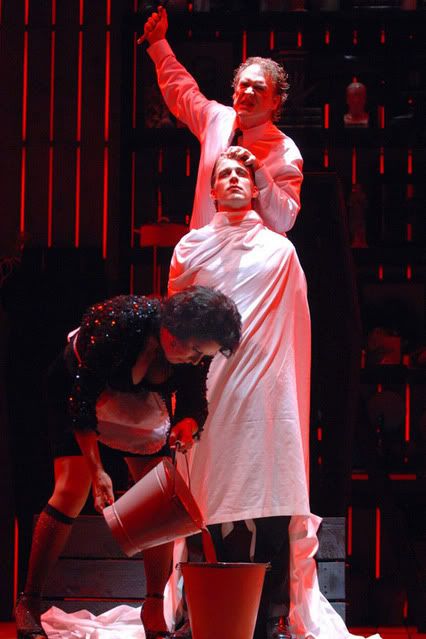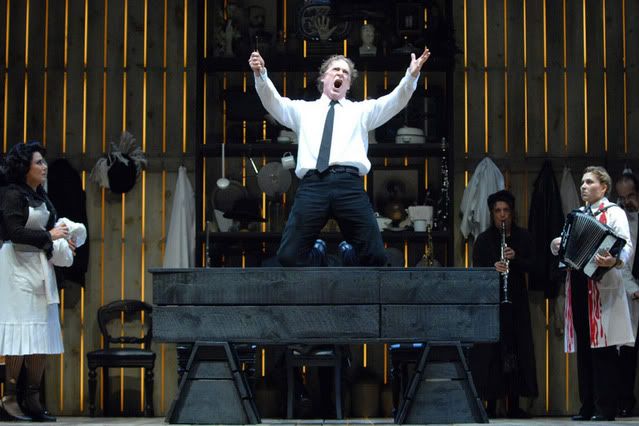Review: `Sweeney Todd’
Opened Sept. 4, 2007 Demons and all, Sweeney Todd resurrected at ACTThree stars Merry musical mayhemLet’s go straight for the jugular here: When it comes to Sweeney Todd: The Demon Barber of Fleet Street, the most important factor is the Stephen Sondheim score.Directors can do their good work with the show. Harold Prince turned the original 1979 Broadway production into grand-scale opera, but the glorious music and the genius lyrics were the star. Nearly 30 years later, British director John Doyle stripped away the 27-piece orchestra and giant cast to expose, yet again, a masterful score by a musical theater composer working at the peak of his craft.San Francisco’s American Conservatory Theater opens its 41st season with Doyle’s bare-bones Sweeney. The production is essentially the Broadway tour – a pre-stop if you will – and it’s exciting and thrilling but unfortunately flawed.Performed in Doyle’s ``actor musician’’ style, the 10 actors play their own instruments. They are cast and orchestra all at once. Why? It’s cheaper. And Doyle’s direction is so precise, and his stage pictures so arresting, it’s actually quite interesting.The concept works largely because the performers are so dazzlingly talented and because it’s always interesting to watch people play instruments. Aside from concerts and trips to the symphony, we don’t get to see instruments played all that often.Sondheim’s score – bolstered by Hugh Wheeler’s sturdy book, which is, in turn, based on Christopher Hampton’s 1973 play – shines in any context. Surprisingly, the actor-musician approach doesn’t slight the music. Sure, this is a chamber musical version – spare, eloquent, a little raw and messy – but it suits the madness of the story. The glorious excess of the original orchestrations is replaced by music supervisor/orchestrator Sarah Travis’ lean, attractive arrangements.In telling the story of a deeply angry, razor-wielding barber exacting revenge on his enemies by slicing their throats and baking their remains into savory meat pies, Sondheim is writing in three basic styles.
Demons and all, Sweeney Todd resurrected at ACTThree stars Merry musical mayhemLet’s go straight for the jugular here: When it comes to Sweeney Todd: The Demon Barber of Fleet Street, the most important factor is the Stephen Sondheim score.Directors can do their good work with the show. Harold Prince turned the original 1979 Broadway production into grand-scale opera, but the glorious music and the genius lyrics were the star. Nearly 30 years later, British director John Doyle stripped away the 27-piece orchestra and giant cast to expose, yet again, a masterful score by a musical theater composer working at the peak of his craft.San Francisco’s American Conservatory Theater opens its 41st season with Doyle’s bare-bones Sweeney. The production is essentially the Broadway tour – a pre-stop if you will – and it’s exciting and thrilling but unfortunately flawed.Performed in Doyle’s ``actor musician’’ style, the 10 actors play their own instruments. They are cast and orchestra all at once. Why? It’s cheaper. And Doyle’s direction is so precise, and his stage pictures so arresting, it’s actually quite interesting.The concept works largely because the performers are so dazzlingly talented and because it’s always interesting to watch people play instruments. Aside from concerts and trips to the symphony, we don’t get to see instruments played all that often.Sondheim’s score – bolstered by Hugh Wheeler’s sturdy book, which is, in turn, based on Christopher Hampton’s 1973 play – shines in any context. Surprisingly, the actor-musician approach doesn’t slight the music. Sure, this is a chamber musical version – spare, eloquent, a little raw and messy – but it suits the madness of the story. The glorious excess of the original orchestrations is replaced by music supervisor/orchestrator Sarah Travis’ lean, attractive arrangements.In telling the story of a deeply angry, razor-wielding barber exacting revenge on his enemies by slicing their throats and baking their remains into savory meat pies, Sondheim is writing in three basic styles. There’s the fist-in-your-gut melodrama of ``The Ballad of Sweeney Todd’’ and ``City on Fire!’’ There’s the broad humor of British music hall in ``The Worst Pies in London’’ and ``By the Sea.’’ And there’s the lilting melodies so gorgeous you practically melt by the end of ``Johanna,’’ ``Pretty Women’’ and ``Not While I’m Around.’’The brilliance of ``A Little Priest,’’ the Act 1 closer, puts the song in a class by itself. Sung by Sweeney and his accomplice, Mrs. Lovett, the song imagines filling meat pies with every kind of human, from vicar to fiddle player. It’s a real man-devouring-man number with the kind of humor and bit that most musicals dream of achieving.The score is served well in Doyle’s 2 ½-hour production (music direction by David Loud), but the Gothic drama suffers.Doyle, who also designed the rough-hewn production (though Richard G. Jones is responsible for the stark, imaginative lighting) begins the show with a vague concept: we’re in an asylum of some kind complete with straightjackets and white lab coats. It’s a shadowy idea that never really amounts to much. (Hey, kids, Marat/Sade sings Sondheim!).This production is so sharp I desperately wanted it to slice into the show more effectively. I hoped for chills and thrills but settled for pleasant entertainment.The cast – seven of the 10 were involved with the Broadway production – is able to shuttle between playing instruments and performing scenes, but few of the performances truly connect.A brilliant observer (my date, actually) said it was like we were watching the understudies get ready for the big show. And that’s it exactly.David Hess as Sweeney has scaled down his demons, which is appropriate for the chamber musical setting, but he’s never really scary enough.Judy Kaye as Mrs. Lovett is appealing and vocally sure, but she misses laughs all over the place. There needs to be something crazy, sexy, sleazy and saintly about Mrs. Lovett, and Kaye is still finding her way through the role.Benjamin Magnuson and Lauren Molina as the young lovers Anthony and Johanna make a strong impression with their cello duets, and the impressive Edmund Bagnell is as strong vocally as he is on the violin.The big disappointment is Keith Buterbaugh as the evil Judge Turpin, who pulls a Woody Allen and attempts to marry his adopted daughter. Buterbaugh’s great on the trumpet, but there’s no menace in his performance. Much better at conveying smiling immorality is Benjamin Eakeley as The Beadle.There’s brilliance in Sweeney Todd, and that comes through in this production, which is, in the end, vivid enough to keep you from missing the full production. If only the razor were sharper.For information about Sweeney Todd: The Demon Barber of Fleet Street, visit www.act-sf.org.
There’s the fist-in-your-gut melodrama of ``The Ballad of Sweeney Todd’’ and ``City on Fire!’’ There’s the broad humor of British music hall in ``The Worst Pies in London’’ and ``By the Sea.’’ And there’s the lilting melodies so gorgeous you practically melt by the end of ``Johanna,’’ ``Pretty Women’’ and ``Not While I’m Around.’’The brilliance of ``A Little Priest,’’ the Act 1 closer, puts the song in a class by itself. Sung by Sweeney and his accomplice, Mrs. Lovett, the song imagines filling meat pies with every kind of human, from vicar to fiddle player. It’s a real man-devouring-man number with the kind of humor and bit that most musicals dream of achieving.The score is served well in Doyle’s 2 ½-hour production (music direction by David Loud), but the Gothic drama suffers.Doyle, who also designed the rough-hewn production (though Richard G. Jones is responsible for the stark, imaginative lighting) begins the show with a vague concept: we’re in an asylum of some kind complete with straightjackets and white lab coats. It’s a shadowy idea that never really amounts to much. (Hey, kids, Marat/Sade sings Sondheim!).This production is so sharp I desperately wanted it to slice into the show more effectively. I hoped for chills and thrills but settled for pleasant entertainment.The cast – seven of the 10 were involved with the Broadway production – is able to shuttle between playing instruments and performing scenes, but few of the performances truly connect.A brilliant observer (my date, actually) said it was like we were watching the understudies get ready for the big show. And that’s it exactly.David Hess as Sweeney has scaled down his demons, which is appropriate for the chamber musical setting, but he’s never really scary enough.Judy Kaye as Mrs. Lovett is appealing and vocally sure, but she misses laughs all over the place. There needs to be something crazy, sexy, sleazy and saintly about Mrs. Lovett, and Kaye is still finding her way through the role.Benjamin Magnuson and Lauren Molina as the young lovers Anthony and Johanna make a strong impression with their cello duets, and the impressive Edmund Bagnell is as strong vocally as he is on the violin.The big disappointment is Keith Buterbaugh as the evil Judge Turpin, who pulls a Woody Allen and attempts to marry his adopted daughter. Buterbaugh’s great on the trumpet, but there’s no menace in his performance. Much better at conveying smiling immorality is Benjamin Eakeley as The Beadle.There’s brilliance in Sweeney Todd, and that comes through in this production, which is, in the end, vivid enough to keep you from missing the full production. If only the razor were sharper.For information about Sweeney Todd: The Demon Barber of Fleet Street, visit www.act-sf.org.